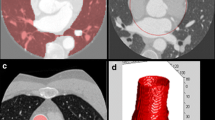Abstract
There are now many physicians, both radiologists and cardiologists who are reporting CT coronary angiography (CTCA) scans who may not be aware that there are many pitfalls present. For the inexperienced reader a significant stenosis in a coronary artery can be easily missed or a moderate stenosis overcalled as significant. Artifacts can also be misinterpreted as representing a significant lesion. It is important that the studies are correctly interpreted, especially as the reported high negative predictive value of CTCA scans is a major strength of this imaging technique. The learning curve of reading these scans is steep and access to conventional coronary catheterisation results is essential for feedback and to improve the readers results. We have developed some rules to aid beginners avoid some of the pitfalls that can occur as these studies are not as easy to read as they may appear initially.










Similar content being viewed by others
References
Stein PD, Beemath A, Kayali F et al. (2006) Multidetector computed tomography for the diagnosis of coronary artery disease: a systematic review. Am J Med 119:203–216
Garcia MJ, Lessick J, Hoffmann MHK (2006) Accuracy of 16-row multidetector computed tomography for the assessment of coronary artery stenosis. JAMA 296:403–411
Hoffman MH, Shi H, Schmitz BL et al. (2005) Noninvasive coronary angiography with multislice computed tomography. JAMA 293:2471–2478
Raff GL, Gallager MJ, O’Neill WW, Goldstein JA (2006) Diagnostic accuracy of non invasive coronary angiography using 64-slice spiral computed tomography. J Am Coll Cardiol 46:552–557
Ehara M, Surmely JF, Kawai M et al. (2006). Diagnostic accuracy of 64-slice computed tomography fro detecting angiographically significant coronary artery stenosis in an unselected consecutive population: comparison with conventional invasive angiography. Circ J 70:564–571
Becker CR (2005) Coronary CT angiography in symptomatic patients. Eur Radiol l 15(Suppl 2):B33–B41
Ohnesorge BM, Hofmann LK, Flohr TG, Schoef UJ (2005) CT for imaging of coronary artery disease: defining the paradigm for its application. Int J Cardiovasc Imaging 21:85–104
Hendel RC, Patel MR, Kramer CM et al. (2006) ACCF/ACR/SCCT/SCMR/ASNC/NASCI/SCAI/SIR 2006 appropriateness criteria for cardiac computed tomography and cardiac magnetic resonance imaging. J Am Coll Cardiol 48:1475–1497
Hyun SC, Choi BW, Choe KO et al. (2004) Pitfalls, artifacts and remedies in multi-detector row CT coronary angiography. Radiographics 24:787–800
Nakanishi TN, Kayashima Y, Inoue R, Sumii K, Gomyo Y (2005) Pitfalls in 16-detector row CT of the coronary arteries. Radiographics 25:425–440
Van Oijen PMA, Ho KY, Dorgelo J, Oudkerk M (2003) Coronary artery imaging with multidetector CT: visualisation issues. Radiographics 23:16e. Published online as 10.1148/rg.e16
Achenbach S (2005) Coronary CT angiography: a cardiologist’s perspective. Appl Radiol (Supplement):22–23
Lawler LP, Pannu HK, Fishman EK. (2005) MDCT evaluation of the coronary arteries, 2004: how we do it-data acquisition, postprocessing, display and interpretation. AJR 184:1402–1412
Hoffman U, Ferencik M, Cury RC et al. (2006) Coronary CT angiography. J Nucl Med 47:797–806
Gerber TC, Breen JF, Kuzo RS et al. (2006) Computed tomographic angiography of the coronary arteries: techniques and applications. Semin Ultrasound CT MRI 27:42–55
Leber AW, Becker A, Knez A et al. (2006) Accuracy of 64-slice computed tomography to classify and quantify plaque volumes in the proximal coronary system: a comparative study using intravascular ultrasound. J Am Coll Cardiol 47:672–677
Cademartiri F, Mollet NR, Ruriza G et al. (2005). Influence of intracoronary attenuation on coronary plaque measurements using multislice computed tomography: observations in an ex-vivo model of coronary computed tomography angiography. Eur Radiol 15:1426–1431
Ota H, Takase K, Rikimaru H et al. (2005) Quantitative vascular measurements in arterial occlusive disease. Radiographics 25:1141–1158
Cury RC, Ferencik M, Achenbach S et al. (2006) Accuracy of 16-slice Multidetector CT to quantify the degree of coronary artery stenosis: assessment of cross sectional and longitudinal vessel reconstructions. Eur Radiol 57:345–350
Cury RC, Pomerantsev H, Ferencik M et al. (2005) Comparison of the degree of coronary stenoses by multidetector computed tomography versus by quantitative coronary angiography. Am J Cardiol 96:784–787
Glagov S, Wisenberg E, Zarins CK et al. (1987) Compensatory enlargement of human atherosclerotic coronary arteries. NEJM 316:1371–1375
Dewey M, Schnapauff D, Laule M et al. (2004) Multislice CT coronary angiography: evaluation of an automatic vessel detection tool. Fortschr Rontgenstr 176:478–483
Khan MF, Wesarg S, Gurung J et al. (2006) Facilitating coronary artery evaluation in MDCT using a 3D automatic vessel segmentation tool. Eur Radiol 16:1789–1795
Achenbach S, Rerencik M, Ropers D et al. (2005) Diagnostic accuracy of image postprocesing methods for the detection of coronary artery stenoses by multi-detector computed tomography. ESC Congress 2005. Abstract P1016
Becker CR, Hong C, Knez A et al. (2003) Optimal contrast application for cardiac 4 detector row computed tomography. Invest Radiol 38:690–694
Cademartiri F, Mollet NR, Lemos P et al. (2006) Higher intracoronary attenuation improves diagnostic accuracy in MDCT coronary angiography. AJR 187:W430–W433
Jacobs JE, Boxt LM, Desjardins B et al. (2006) ACR practice guideline for the performance & interpretation of cardiac computed tomography. J Am Coll Radiol 3:677–685
Rumberger JA (2006) Noncardiac abnormalities in diagnostic cardiac computed tomography: within normal limits or we never looked! J Am Coll Cardiol 48:407–408
Author information
Authors and Affiliations
Corresponding author
Rights and permissions
About this article
Cite this article
Hoe, J.W.M., Toh, K.H. A practical guide to reading CT coronary angiograms—How to avoid mistakes when assessing for coronary stenoses. Int J Cardiovasc Imaging 23, 617–633 (2007). https://doi.org/10.1007/s10554-006-9173-9
Received:
Accepted:
Published:
Issue Date:
DOI: https://doi.org/10.1007/s10554-006-9173-9




